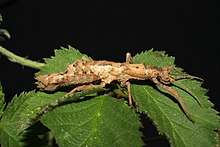Heteropterygidae
The Heteropterygidae[1] is a family of stick insects belonging to the suborder Verophasmatodea; species can be found in Australasia, East and Southeast Asia.[2]
| Heteropterygidae | |
|---|---|
 | |
| Pylaemenes guangxiensis | |
| Scientific classification | |
| Kingdom: | Animalia |
| Phylum: | Arthropoda |
| Class: | Insecta |
| Order: | Phasmatodea |
| Infraorder: | Areolatae |
| Family: | Heteropterygidae Kirby, 1896 |
Subfamilies and Genera
The Catalogue of Life[1] and Phasmida Species File[2] list three Subfamilies:
Dataminae
Authority: Rehn & Rehn, 1939; contains the single tribe Datamini (Asia including China and Japan)
- Dares Stål, 1875
- Epidares Redtenbacher, 1906
- Hainanphasma Ho, 2013
- Orestes Redtenbacher, 1906
- Planispectrum Rehn & Rehn, 1939
- Pylaemenes Stål, 1875
- Spinodares Bragg, 1998
- Woodlarkia Günther, 1932
Heteropteryginae
Authority: Kirby, 1896; contains the single tribe Heteropterygini (Australasia, Tropical Asia from Indo-China)
- Haaniella Kirby, 1904
- Heteropteryx Gray, 1835
Obriminae
Authority: Brunner von Wattenwyl, 1893 (Sri Lanka, Malesia, Pacific)
- Aretaon Rehn & Rehn, 1939
- Brasidas Rehn & Rehn, 1939
- Eubulides Stål, 1877
- Euobrimus Rehn & Rehn, 1939
- Hennobrimus Conle, 2006
- Heterocopus Redtenbacher, 1906
- Hoploclonia Stål, 1875
- Ilocano Rehn & Rehn, 1939
- Mearnsiana Rehn & Rehn, 1939
- Miniopteryx Zompro, 2004
- Miroceramia Günther, 1934
- Obrimus Stål, 1875
- Pterobrimus Redtenbacher, 1906
- Stenobrimus Redtenbacher, 1906
- Sungaya Zompro, 1996
- Theramenes (insect) Stål, 1875
- Tisamenus (insect) Stål, 1875
- Trachyaretaon Rehn & Rehn, 1939
gollark: <@!236628809158230018> https://pastebin.com/4wHueLX4
gollark: I already *did*.
gollark: I can do that in my 550 or so byte one.
gollark: You can also just completely remove the `print`s if you want to save more.
gollark: Yay?
References
- Roskov Y.; Kunze T.; Orrell T.; Abucay L.; Paglinawan L.; Culham A.; Bailly N.; Kirk P.; Bourgoin T.; Baillargeon G.; Decock W.; De Wever A. (2011). Didžiulis V. (ed.). "Species 2000 & ITIS Catalogue of Life: 2011 Annual Checklist". Species 2000: Reading, UK. Retrieved 24 September 2012.
- "Heteropterygidae". Phasmida Species File. Retrieved 15 April 2018.
External links


This article is issued from Wikipedia. The text is licensed under Creative Commons - Attribution - Sharealike. Additional terms may apply for the media files.